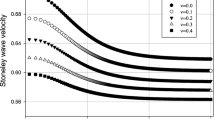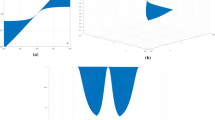Abstract
In various areas of the acoustic NDT starting from nano and micro scales to geophysical scales, the high frequency Stoneley waves can give essential information on the physical properties of the adjacent layers along with information on possible interfacial cracks and other defects. The Wiechert condition imposed on the relation between bulk wave velocities of the contacting layers, play an important role in acoustic analyses, especially at analyzing high-frequency Stoneley waves arising and propagating along the interfaces. The present study concerns with a non-propagating condition for Stoneley waves at the vicinity of the Wiechert condition.
Similar content being viewed by others
Avoid common mistakes on your manuscript.
1 Introduction
In various areas of the acoustic NDT starting from nano and micro scales to geophysical scales, the high frequency Stoneley waves can give essential information on the physical properties of the adjacent layers along with information on possible interfacial cracks and other defects. The Wiechert condition imposed on the relation between bulk wave velocities of the contacting layers, play an important role in acoustic analyses, especially at analyzing high-frequency Stoneley waves arising and propagating along the interfaces. The present study concerns with a non-propagating condition for Stoneley waves at the vicinity of the Wiechert condition.
In the original paper [1] Stoneley deduced an equation for finding speed of propagation of an interface surface wave travelling along the interface between two elastic isotropic halfspaces in mechanical contact
where \(c\) is the desired Stoneley wave velocity; \(\uprho_{1} ,\,\,\uprho_{2}\) are the material densities of the halfspaces; and
In Eqs. (2) \(\upalpha_{k} ,\,\,\upbeta_{k}\) are respectively longitudinal and shear bulk wave velocities in the corresponding halfspaces:
where \(\uplambda_{k}\) and \(\upmu_{k}\) are Lame constants.
The main attention in Stoneley’s work was paid to the important in geophysics case when elastic properties of both media satisfy the Wiechert condition [2]:
Stoneley’s asymptotic analysis of Eq. (1) based on Taylor’s expansions of expressions for \(A_{k} ,\,\,B_{k}\) at small \(c\) allowed him to conclude that at the condition (4) there is the unique real root of Eq. (1):
Stoneley also asserted that such a root satisfies the following condition
Note that at condition (4) there is no need in indices of the bulk wave velocities.
The Eq. (1) was numerically analyzed by Sezawa and Kanai [3] for the case of Poisson’s media, when
The condition (7) is satisfied at Poisson’s ratios \(\nu_{k} = \tfrac{1}{4},\,\,\,\,\,k = 1,2\). Numerical analysis of Eq. (1) at condition (7) gave the following range of the Stoneley wave existence [3]
In Fig. 1 dashed diagonal line corresponds to the media satisfying Wiechert condition (4); and the region of existence is the narrow part between two curves; while curves correspond to the limiting cases of existing real and positive roots of Eq. (1) that satisfy the following relation
Note that relation (8) ensures real coefficients of Eq. (1). The plots initially obtained through numerical analysis by Sezawa and Kanai [3] were also (numerically) confirmed by Cagniard [4] and Scholte [5, 6].
Despite quite a large number [7,8,9,10,11,12,13,14,15,16,17,18,19,20,21] of studies on Stoneley waves propagating in isotropic and anisotropic media, existence of Stoneley waves at the vicinity of the point \(A\) (see Fig. 1), where both contacting media have identical physical properties, has not been questioned. However, it will be demonstrated below that not only a singular point \(A\), but also it’s open vicinity does not belong to the region of existence. The fact of nonexistence of Stoneley waves in a broader range at the vicinity of point \(A\), can have various applications starting from non-destructive testing of stratified composites containing micro and nano layers to geophysics.
2 Theoretical considerations
Consider point \(A\), where according to the Wiechert condition Eq. (4) and Poisson’s relation (7):
Thus, acoustically both contacting media become identical, so the two halfspaces eventually form a single homogeneous space without any interfaces. But, in a homogeneous space no surface waves can propagate [22], so at least one point \(A\) should be excluded from the region of existence.
Moreover, direct verification reveals that Eq. (1) at condition (9) yields
where in view of (9) indices at \(\uprho ,\upalpha ,\,\,\upbeta\) are omitted. Now, Eq. (10) has eight roots
none of which satisfies conditions for the propagating Stoneley wave.
Now, it is necessary to show that along with the point \(A\), an open vicinity of that point should also be excluded from the region of existence. To prove that consider the left-hand side of Eq. (1) which can be considered as a continuous function of the \(c\) variable:
\({\mathbb{C}}\) is the complex plane. In view of continuity of \(P(c)\), solutions of Eqs. (1), (5) and (6) form a closed subset \(B \subset {\mathbb{C}}\). Thus, the region of existence should be closed, however, exclusion point \(A\) from \(B\) makes the solution subset \(B\backslash A\) being not closed, but the latter means that an open vicinity of the point \(A\) should also be excluded.
3 Numerical analysis
Computing the roots of Eq. (1) obeying conditions (5), (6) for Poisson’s media satisfying condition (7) and other media with equal Poisson’s ratios, yields the following results for the region of Stoneley wave existence, presented in Fig. 2.
The plots in Fig. 2 clearly indicate that along with point \(A\) with coordinates \((1;1)\) a vicinity of that point also does not belong to the region of existence of Stoneley waves for the studied Poisson’s ratios. Computations were made using multiprecision algorithms [23] with long mantissas up to ~ 1000 decimal digits to minimize possible round of errors in finding roots of Eq. (1).
4 Concluding remarks
Both theoretical and numerical analyses revealed a more complicated structure of the Stoneley wave region of existence. In particular, for contacting halfspaces with Poisson’s ratios varying from 0.0 to 0.499, the corresponding regions of existence are doubly connected, see Fig. 2.
The obtained result may be relevant in various geophysical applications, since in the pioneering works [1,2,3,4,5], and in quite a large number of the subsequent studies in theoretical and applied geophysics and wave dynamics [6,7,8,9,10,11,12,13,14,15,16,17,18,19,20,21,22, 24,25,26,27,28,29,30] it was implicitly assumed that the region of existence for Stoneley waves is simply connected with point (1;1) belonging to that region.
References
Stoneley R (1924) Elastic waves at the surface of separation of two solids. Proc R Soc Lond Ser A Math Phys Sci 106:416–428
Sezawa K (1938) Formation of boundary waves at the surface of a discontinuity within the Earth's crust. Bull Earthq Res Inst Tokyo Univ 16:504–511
Sezawa K, Kanai K (1939) The range of possible existence of Stoneley waves, and some related problems. Bull Earthq Res Inst Tokyo Univ 17:1–8
Cagniard L (1939) Reflexion et Refraction des Ondes Seismiques Progressive. Gauthier- Villard, Paris
Scholte JG (1942) On the Stoneley wave equation. Proc Koninklijke Nederlandsche Akademie van Weten-schappen 45:159–164
Scholte JG (1947) The range of existence of Rayleigh and Stoneley waves. Geophys J Int 5(5):120–126
Ginzbarg AS, Strick E (1958) Stoneley-wave velocities for a solid-solid interface. Bull Seismol Soc Am 48(1):51–63
Lim TCT & Musgrave MJP (1970) Stoneley waves in anisotropic media. Nature 225:372
Lee DA, Corbly DM (1977) Use of interface waves for nondestructive inspection. IEEE Trans Sonics Ultrason 24:206–212
Murty GS (1975) A theoretical model for the attenuation and dispersion of Stoneley waves at the loosely bonded interface of elastic half spaces. Phys Earth Planet Inter 11:65–79
Murty GS (1975) Wave propagation at an unbounded interface between two elastic half-spaces. J Acoust Soc Am 58:1094–1095
Rokhlin S, Hefet M, Rosen M (1980) An elastic interface wave guided by a thin film between two solids. J Appl Phys 51:3579–3582
Barnett DM, Lothe J, Gavazza SD, Musgrave MJP (1985) Consideration of the existence of interfacial (Stoneley) waves in bonded anisotropic elastic half-spaces. Proc R Soc Lond Ser A Math Phys Sci 412:153–166
Stevens JL, Day SM (1986) Shear velocity logging in slow formations using the Stoneley wave. Geophysics 51:137–147
Barnett DM, Gavazza SD, Lothe J (1988) Slip waves along the interface between two anisotropic elastic half-spaces in sliding contact. Proc R Soc Lond Ser A Math Phys Sci 415:389–419
Norris AN (1989) Stoneley-wave attenuation and dispersion in permeable formations. Geophysics 54(3):330–341
Djeran-Maigre I, Kuznetsov SV (2011) Soliton-like Lamb waves in layered media. In: Vila RP (ed) Waves in fluids and solids. IntechOpen, London
Chi VP, Ha GPT (2012) Uniqueness of Stoneley waves in pre-stressed incompressible elastic media. Int J Non-Linear Mech 47:128–134
Kuznetsov SV (2019) Abnormal dispersion of flexural Lamb waves in functionally graded plates. Z Angew Math Phys 70(89):1–10
Kuznetsov SV (2019) Abnormal dispersion of Lamb waves in stratified media. Z Angew Math Phys 70(175):1–8
Kuznetsov SV (2019) Lamb waves in stratified and functionally graded plates: discrepancy, similarity, and convergence. Waves Random Complex Media 30:2–11
Achenbach JD (1987) Wave propagation in elastic solids. North-Holland series in applied mathematics and mechanics, vol 16. North-Holland, Amsterdam
Bailey DH (1993) Automatic translation of Fortran programs to multiprecision. NASA RNR Technical Report, RNR-91-025, pp 1–21
Stoneley R (1934) The transmission of Rayleigh waves in a heterogeneous medium. Mon Not R Astron Soc (Lond) Geophys Suppl 3:222–232
Koppe H (1948) Uber Rayleigh-Wellen an den Oberflache zweier Medien. Z Angew Math Mech 28:355–366
Eringen AC, Suhibi ES (1971) Elastodynamics: linear theory, vol 2. Academic Press Inc, New York
Takeuchi H, Saito M (1972) Seismic surface waves. In: Bolt BA (ed) Methods of computational physics, vol 11. Academic Press, New York, pp 217–295
Bullen KE, Bolt BA (1985) An introduction to the theory of seismology, 4th edn. Cambridge University Press, Cambridge
Gaherty JB (2004) A surface wave analysis of seismic anisotropy beneath eastern North America. Geophys J Int 158:1053–1066
Dal Moro G (2014) Surface wave analysis for near surface applications. Elsevier, New York
Author information
Authors and Affiliations
Corresponding author
Additional information
The author’s work was partially supported by the Russian Foundation for Basic Research, Grant No. 20-08-00419.
Rights and permissions
About this article
Cite this article
Ilyashenko, A.V. Stoneley waves in a vicinity of the Wiechert condition. Int. J. Dynam. Control 9, 30–32 (2021). https://doi.org/10.1007/s40435-020-00625-y
Received:
Revised:
Accepted:
Published:
Issue Date:
DOI: https://doi.org/10.1007/s40435-020-00625-y






